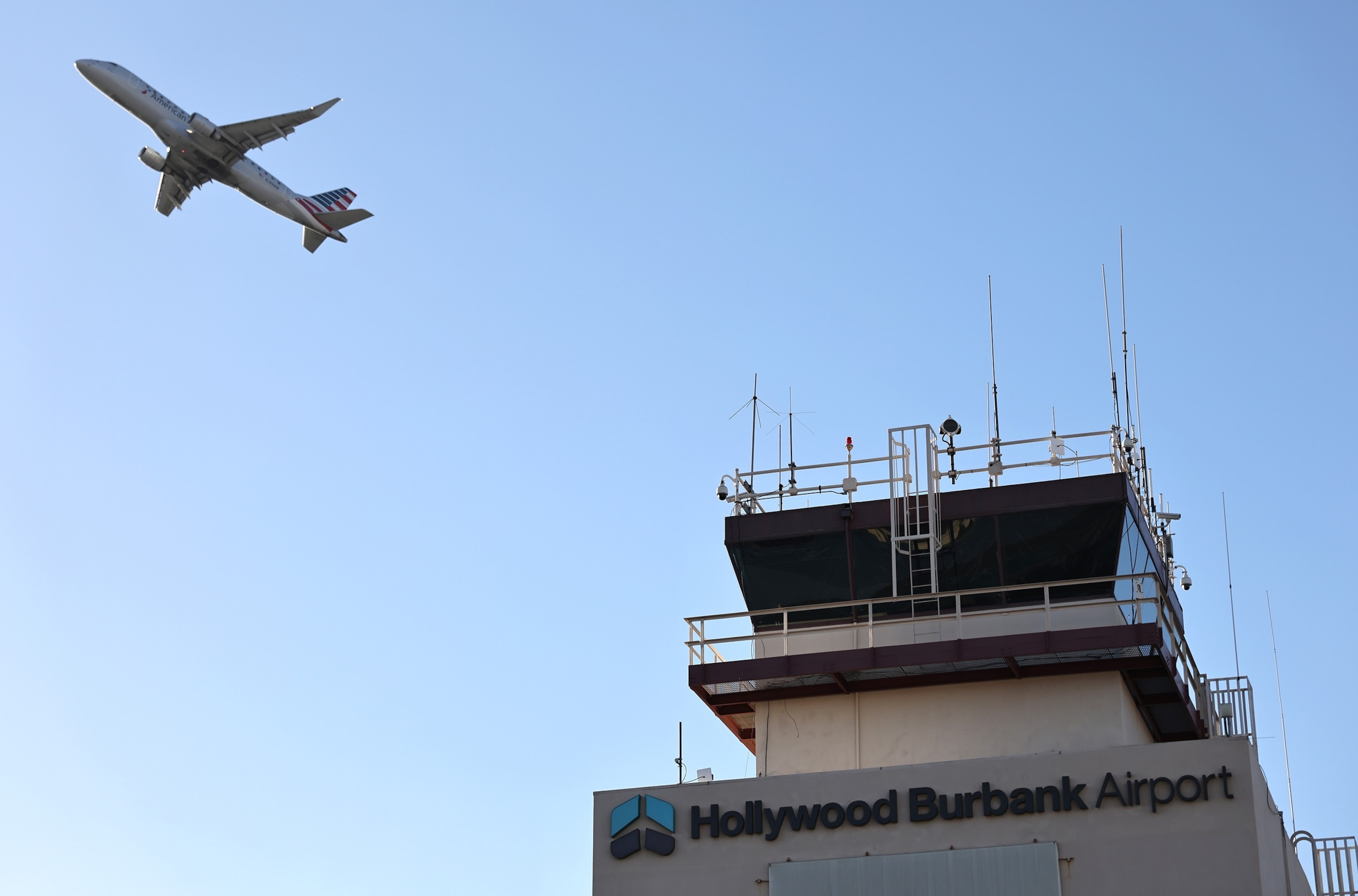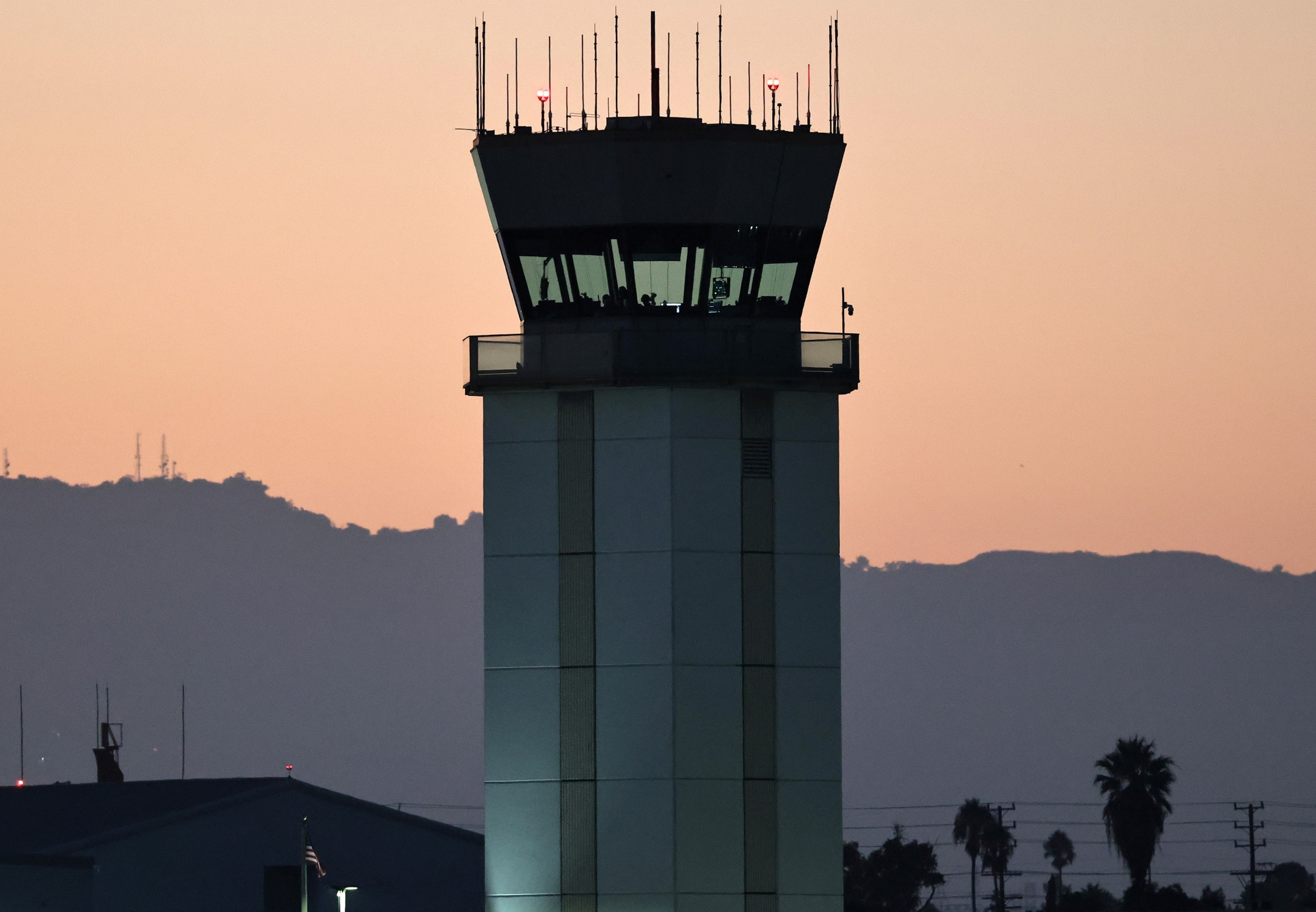A week into the government shutdown, sick calls from air traffic controllers are beginning to cause delays and cancellations, as several airport towers and control facilities do not have enough staff to properly handle all flights.
Drivers are considered essential workers and are exempt from being furloughed during a shutdown. An estimated 13,294 drivers will continue to work without pay during the shutdown, according to the Department of Transportation’s shutdown plan.
Burbank Airport in California was the hardest hit on Monday and was forced to close its tower from 4:15 p.m. to 10 p.m. PDT because it had no air traffic controllers, according to FAA documents.

An American Eagle aircraft takes off from Hollywood Burbank Airport on October 6, 2025 in Burbank, California.
Mario Tama/Getty Images
The airport remained open but flights were delayed on average by more than 2.5 hours. Controllers at a San Diego facility handled traffic entering and leaving Burbank during the tower closure.
“Clearance is closed. Ground is closed. Venue is closed. Tower is closed due to lack of staff. Simply contact SoCal at the 1-800 number in the green book to obtain your clearance,” a controller can be heard informing pilots of air traffic control recordings, referring to a published list of airport information.
Several other ATC facilities also experienced staffing issues on Monday. Philadelphia TRACON (Terminal Radar Approach Control), Denver Center, Detroit TRACON, Indianapolis Center, Phoenix Airport and Phoenix TRACON also received notices from Federal Aviation Administration personnel. More than 600 flights on Monday were delayed in and out of the Denver airport and more than 200 at the Phoenix airport.
“There have been increased staffing shortages across the system. When that happens, the FAA slows traffic at some airports to ensure safe operations,” the agency said in a statement to ABC News.
The National Air Traffic Controllers Association (NATCA), the union that represents controllers nationwide, said it is working with the FAA to mitigate any disruption to the national airspace.
“It is normal for some air traffic controllers to call in sick on any given day, and this is the latest example of how fragile our aviation system is amid a national shortage of these critical safety professionals,” NATCA said in a statement to ABC News.
While ATC staffing is at critical levels across the country, it is rare to have impacts on flights due to staffing shortages in places like Arizona or California, according to FAA documents reviewed by ABC News.
Transportation Secretary Sean Duffy said at a news conference Monday that sick calls from controllers have spread across the region and not from a specific airport or ATC facility, but acknowledged that staffing levels at certain facilities have dropped by as much as 50 percent.
“We don’t have any facilities that have had long-term issues with sick leave. But that worries me. And if someone has to take sick leave, drive Uber to make a difference, those are decisions they’re going to make themselves. But of course, that’s concerning to us,” Duffy said.
“These are highly skilled, high-performing, safety-oriented professionals who I don’t want driving to work,” Duffy added. “I don’t want them to find a second job to pay the bills. I want them to get paid for the work they are doing today, keeping our planes in the air and our skies safe.”
Duffy met Monday with controllers who manage Newark airspace and said they expressed concern about the additional financial stress of the closure on an already demanding job.

The Hollywood Burbank Airport air traffic control tower is located on October 6, 2025, in Burbank, California.
Mario Tama/Getty Images
“The constant message from these controllers was that now they’re not just thinking about the airspace and the jobs they have to do at these TRACON towers or centers around the country. They’re thinking about ‘am I going to get a paycheck?'” Duffy said. “So now what they’re thinking as they control our airspace is, ‘How am I going to pay my mortgage? How do I make my car payment? I have a couple of kids at home, how do I put food on the table? I’m working six days a week; do I have to take a second job and drive Uber when I’m already exhausted from doing a job that’s already stressful to think about?'”
Air traffic controllers will receive a partial pay check on Oct. 14, but will not be paid on Oct. 28 if the shutdown continues, according to NATCA. Under the Government Employees Fair Treatment Act of 2019 (GEFTA), controllers will receive back pay once the shutdown ends.
The staffing crisis also sparked some heated political exchanges on social media. California Governor Newsom published in Xsaying, “Thank you @realDonaldTrump! Burbank Airport has ZERO air traffic controllers from 4:15pm to 10pm today due to YOUR government shutdown.”
Transportation Secretary Sean Duffy responded to Newsom: destination“Breaking news! Your Democrat friends shut down the government because they want Americans to pay for illegals’ health care. And no state has more illegals than California! You care more about illegals than our hard-working American air traffic controllers. If you’re looking for someone to blame, look in the mirror; we all know it’s your favorite thing to do.”
Another aspect of air travel affected by the shutdown, which is on the verge of running out of funding, is the Essential Air Service (EAS) program. Duffy said the EAS program, which provides airlines with subsidies to fly to rural areas that would otherwise have no air service because the route would not be profitable, will run out of funds on Sunday, October 12.
“Air carriers that continue to operate EAS flights beyond October 12, 2025 will do so at their own risk, as the Department may not be able to pay the contracted subsidy,” the DOT said in a notice. The notice also says that if carriers continue to operate during the funding period, they could receive a “prorated” refund, meaning they may not receive the full amount owed.
The greatest impacts would be felt in Alaska, where air travel is the primary means of transportation. Alaska Senator Lisa Murkowski published in X, saying, “The critical assistance these routes provide makes a disruption on any scale detrimental to these communities and the local airlines that serve them.”
Murkowski said she is working with the administration to find a solution.




